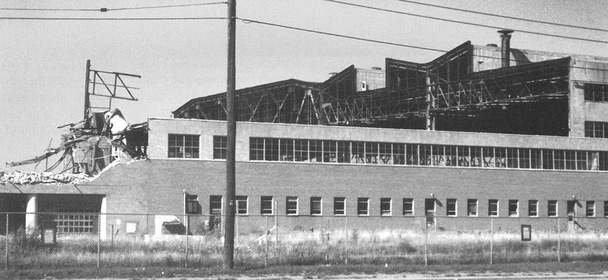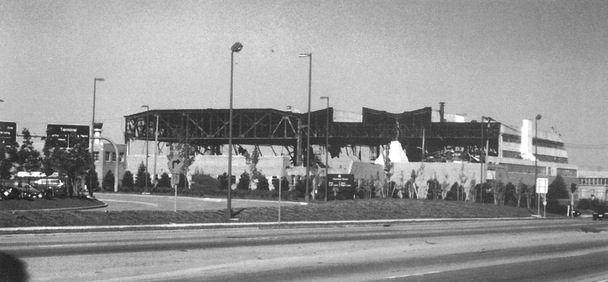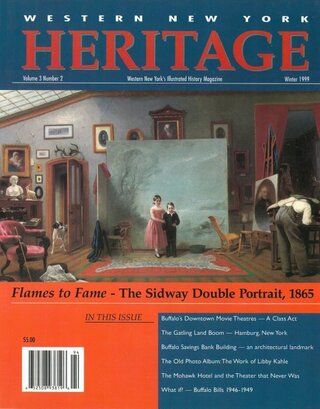
Westinghouse Plant under demolition from Genesee Street. The high bay with butterfly clerestories housed the T-line systems controls. To the rear was the F-Motor Line.
Photo: John Conlin
The demolition of most of the buildings covered in “Last Look” has been lamented. But when the old Westinghouse plant on Genesee Street near the Buffalo-Niagara Airport was demolished, many local residents cheered. “It’s about time that ugly old eyesore was torn down,” was a typical response. Yet the building has played a significant part in Western New York since its opening as Curtiss-Wright in 1941.
The federal government commissioned the building at a time when the need for factories had never been greater: late 1940, the start of World War II. Famed industrial architect Albert Kahn designed the plant, and for five years, local “Rosie the Riveters” came to work every day to build P-40 fighter aircraft. The building also housed the test pilots that flew the planes out of the Buffalo Airport. At the end of the war, the 2.5-million-square-foot complex (main building and annexes) was sold to the Westinghouse Electric Corporation, who bought it from the Reconstruction Finance Corporation for close to ten million dollars. Westinghouse relocated their factory operations from East Pittsburgh to Buffalo, and relocated their offices from the Ellicott Square Building to the plant on Genesee Street.
The first plant boss was Leon Ludwig, the co-winner of the 1933 American Institute of Electrical Engineers’ Prize. They opened in March of 1946 with 500 employees; by the end of the year they had about 6,000 employees. For forty years, thousands of people were employed in Westinghouse’s five divisions: the copper mill, the gear line, welding, large and small motor operations and the electronic and assembly control sections. Although there was a history of labor problems, by and large the plant was very productive and was considered a good place to work. In fact, Westinghouse expanded its operations here several times.
However, tragedy struck the plant twice in its history. The first came in 1942, when the building was still Curtiss-Wright. One of the P-40 aircraft caught fire over Lackawanna during a test flight. The pilot bailed out, hoping the plane would crash in the lake, but instead, the plane circled around and crashed into the plant, killing 14 and injuring 28. A plaque in memory of the 14 dead was placed in the plant, but by the time the plant was torn down, no one had seen it in years or knew anything of its whereabouts.

Westinghouse Plant demolition (from the southwest) showing the structural steel framing of the Albert Kahn building with the moderne style administration building at the right.
Photo: John Conlin
The second tragedy came thirty-five years later, in 1977. Again, it was a plane crash. A mail carrier bound for Rochester became distressed shortly after take-off and tried to return to the airport. Instead, it crashed through the roof of the Westinghouse building. The aircraft’s pilot died shortly after the crash. Clifford Kuzniarek, a 25-year-old dispatcher with Westinghouse, was severely burned in the crash. He died several weeks later. Miraculously, no other Westinghouse employees were even injured, although there were several hundred people in the plant at the time of the crash.
In the early 1980’s, Westinghouse began to downsize its operations, and the plant on Genesee Street closed. The NFTA wanted the building, but instead, it was sold to a local developer, who failed to pay taxes on it and let the building deteriorate into the eyesore that most Western New Yorkers will inevitably think of when they remember this building. Early this year, an agreement was reached, and in April, a banner appeared on the building, announcing: “OSC: Ontario Specialized Contracting.” The cranes and bulldozers followed, and for the next six months, commuters and travelers were treated to the spectacle of a large-scale demolition project, the likes of which will not be seen in this area for a long time, if ever again. It culminated in October, when the central part of the main building came down. Former Curtiss-Wright and Westinghouse employees were on hand to watch as the last of their old workplace was demolished. As we go to press, the remains of the building are being cleaned up. The concrete is being pulverized into gravel-sized particles, and the steel is being salvaged. Both are carted off daily by dump trucks. The entire Westinghouse plant will live a second life, scattered into new homes and businesses in the area. This process, too, has become a popular spectacle for certain area residents, who watch from the Arby’s across the street.
But it is almost a certainty that none of the new homes and businesses will play the significant role that the Westy building did. Ray Dusza, an Erie County legislator and former Westinghouse employee, says “For the former Curtiss-Wright and Westinghouse employees, [the plant] was not an ‘ugly eyesore,’ but a historic part of Cheektowaga.”
Many area residents would disagree. Some may have even volunteered to level the place themselves. But for many years, the building provided thousands of jobs and created quality products that are still in use today. For this reason, and for the memory of the 29 people killed in accidents during the plant’s history, the old Westy building deserves one last look.








